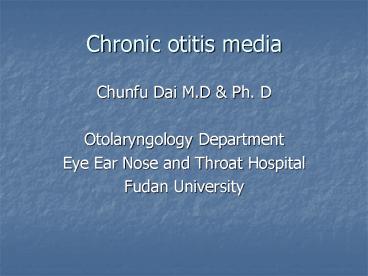Chronic otitis media - PowerPoint PPT Presentation
1 / 25
Title:
Chronic otitis media
Description:
Chronic otitis media Chunfu Dai M.D & Ph. D Otolaryngology Department Eye Ear Nose and Throat Hospital Fudan University Definition COM: unresolved inflammatory ... – PowerPoint PPT presentation
Number of Views:168
Avg rating:3.0/5.0
Title: Chronic otitis media
1
Chronic otitis media
- Chunfu Dai M.D Ph. D
- Otolaryngology Department
- Eye Ear Nose and Throat Hospital
- Fudan University
2
Definition
- COM unresolved inflammatory process of the
middle ear and mastoid associated with TM
perforation, otorrhea and hearing loss.
3
Etiology
- Unresolved middle ear infection.
- Uncomplicated inflammatory process of the middle
ear may evolve over time to produce persistent
effusion and irreversible mucosal change - Fluid contains enzymes to alter the mucosal
lining of the middle ear, it results in collapse
or chronic perforation - Obstruction of narrow communication between the
antrum and the attic, the aditus.
4
Etiology
- Dysfunction of Eustachian tube
- Chronic inflammation in nose and pharynx
- Dysfunction of immune system
5
Bacteriology
- Pseudomonas aeruginosa (40-60)
- Straphylococus aureus (10-20)
- Anaerobic bacteria
6
Pathology
- Middle ear mucosa is lined by secretory
epithelium forming glandlike structure. - Hyalinization or tympanosclerosis
- A healing response
- It occurs during quiescent periods
- It is formed by fused collagenous fibers
- It is hardened by the deposition of calcium and
phosphate crystals - Conductive hearing loss is associated with masses
restricting ossicular mobility
7
Pathology
- Ossicular erosion is frequent in COM
- Infection process per se
- Necrosis following vascular thrombosis
- It most commonly affect the lenticular process of
the incus and head of the stapes
8
Pathology
- Cholesterol granulomas
- Presence of yellowish masses surrounded by
granulation tissue, edematous mucosa and fibrous
tissue - It contains many cholesterol crystals and foreign
body giant cells.
9
Pathology
- Cholesteatoma cystlike, expanding lesions of the
temporal bone, lined by stratified epithelium and
containing desquamated keratin and purulent
material. - Classification
- Congenital cholesteatoma
- Acquired cholesteatoma
10
Pathology
- Mechanics of mucosal transformation and
epithelial ingrowth have been the focal point of
cholesteatoma - Pocket retraction dysfunction of Eustachian tube
11
Pathology
- Epithelial migration the edge of a peripheral
perforation - Inward growth of the surface epithelium follows
papillary proliferation of the germinative layer
of the pars flaccida. - Metaplasia from pseudostratified ciliated
columnar epithelium
12
(No Transcript)
13
Cholesteatoma Formation
14
Cholesteatoma Formation
15
Pathology
- Pathogenesis of congenital cholesteatoma
- Ectodermal epithelial in proximity of the
geniculate ganglion, medial to the neck of the
malleus
16
Pathology
- Diagnosis criteria
- Patients without previous history of ear disease,
with normal and intact TM - The temporal bone pneumatization should be normal
17
Clinical presentations
- Otorrhea
- Malodorous associated with cholesteatoma
- Hearing loss
- Air conduction threshold is within 40 dB means TM
proferation with intact ossicular chain - If air-bone gap is more than 40 dB is associated
with discontinuity of ossicular chain
18
Clinical presentations
- Physical findings
- Defect in the pars tensa of TM or the pars
flaccida or both - Atelectatic lesions in tensa or flaccida pars
- Squamous epithelial invasion may invade middle
ear - Granumoms, polyps, tympanosclerotic plaques in
middle ear
19
Radiographic evaluation
- Indications for image study
- Uncontrollable aural discharge
- Complications such as facial paralysis,
labyrinthitis - When central nervous stystem involvement is
suspected, MRI should be considered. - Coronal CT scan is perferred
20
Differential diagnosis
- Tuberculous otitis media
- Hematogenous route
- Multiple perforation and fetid
- Creamy aural discharge
- Active pulmonary disease
- Multiple antituberculosis agents
21
Differential diagnosis
- Middle ear carcinoma
- Middle age patient
- Long term otorrhea with blood
- Otalgia
- Neoplasm in tympanum
- CT scan showed temporal bone destruction
22
Managements
- Medical treatment
- Goals
- Infection control
- Stabilization of process
- Prevention of irreversible damage and development
of serious complications - 3H202 clears up pus then antibiotics ear drops
is used. - With the decrease of pus, 3 boric glycerin, 3
boric alcohol can be used - No aminoglycoside ear drops
- No powders containing antibiotic and erosion ear
drugs
23
Managements
- Surgery
- Goals
- Safe ear lesion removal
- Dry ear
- Hearing ear reconstruction of ossiclar chain
- classification
- Myrigoplasty
- Tympanoplasty
- Tympanoplasty with mastoidectomy
24
(No Transcript)
25
(No Transcript)































